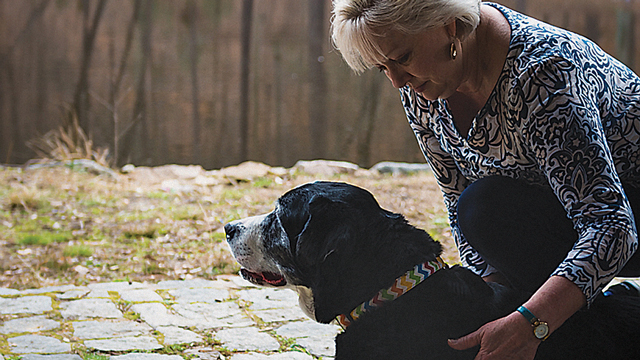Family folklore has it that I have loved dogs ever since I was born – even before I could walk or talk. Due to an incident in her childhood, my mother was afraid of dogs, especially large ones, so we didn’t have a dog of our own. Our neighbors across the street, however, had a handsome German shepherd named Teddy, and he decided to adopt me. This was back in the day when most dogs ran free. Whenever my mother came out of the house with me in the stroller, Teddy would rush over to accompany us. My mother, of course, was terrified of him. But he paid no attention to her. He walked along beside me, and if someone would approach to admire me, Teddy would move to the front of the stroller. He did not take kindly to strangers admiring his little human, and he would often bare his teeth and produce a low rumbling growl to warn them away.
Fast forward sixty-one years, and still, I am fascinated by dogs, and I adore them. I cannot imagine a household without one. I think having a dog helps teach children empathy and compassion, and a well-behaved dog helps adults relax. Even medical experts have weighed in on the benefits of owning a dog, providing scientific proof that petting a dog can lower your blood pressure.
Not everyone has the lifestyle that is necessary to have a happy, well-adjusted dog. If you are thinking about getting a dog, I would ask you to consider the following points.
1. Activity Level Do not get a dog that needs more activity than you are presently capable of giving. If your family is rarely home, you may want to wait until that changes. Dogs are not solitary animals and should not be left home alone most of the time.
2. Personality Do not base your decision on the way a dog looks. Base your decision on the characteristics of a breed. Research the breed and find out what it needs to be happy and well adjusted. Find out what diseases it is prone to, and find out what it was originally bred to do. If the breed is not known, listen to the person who knows the most about the dog’s personality. Base your decision on personality.
3. Size Small dogs can be seriously hurt by roughhousing with kids or larger animals. Large dogs can unintentionally knock a toddler down with their exuberance. Dogs and children need to be supervised when playing together. They can seriously hurt one another if not properly supervised.
4. Age Puppies need lots of rest, must be house-trained, crate-trained, and supervised closely for at least the first four to six months of life. Adult dogs may already be house- and crate-trained and may have some experience with children. Older dogs, even a dog you have owned for his whole life, can become less eager to play as they age and becomes a bit grumpy.
5. Time Commitment There is feeding, walking, vetting, bathing, and yard cleanup that will need to be done. And, vacuuming – lots of vacuuming! You may want to assign your child or children tasks to help take care of the dog. But, remember, ultimate care for the dog is the adults’ responsibility.
6. Cost You will need a collar and leash, food and water bowls, a crate and mat, food, and some dog toys, just to name the basics. Then, of course, there are vet fees, training, plus, the possibility of grooming and boarding. Dogs in our area (in the southeastern states in general) need to be kept on heartworm and flea preventative year-round so that needs to be considered as well. If your dog does not come chipped with a microchip, I would highly recommend having that done as well.
7. Training Who will train your dog? Dogs, like children, need training. If you are new to dog ownership, I would recommend taking your dog to training classes. There are many available. A dog cannot behave to your expectations if the dog cannot understand what they are. Dogs don’t speak our language! Training will teach both you and your dog how to communicate with each other, and it helps create a strong bond between you. Many classes allow older children to come and learn as well.
8. Housing Where will your dog live, sleep, and stay when you are away from home? Dogs are meant to live with people and/or other dogs. If you plan on keeping your dog on a chain or always in the yard, please don’t get a dog. This is no life for them. They are social animals. That said, I believe that all dogs, no matter what size, need a safe space to be able to run and play. That’s why a securely fenced yard is required by most rescue organizations before you adopt.
9. Commitment Will you be committed to your dog? Will you love him until death do you part? The average life span of a dog in the United States is fourteen years. To your dog, you are his pack. Anything that causes your dog to be separated from you will be detrimental to him and cause suffering. So, will you be there for your dog through your new babies, relocations, illnesses, and old age? Will you be there when that hard decision has to be made to end suffering? Will you be there comforting your dog as it slips away from this life to wait for you at the Rainbow Bridge? If you cannot make this kind of commitment, please wait to get a dog until you can.
10. Finding Your Dog There are only two options I would recommend you consider. One is to purchase a puppy from a dedicated breeder. This is a breeder who shows their dogs and will be happy for you to come and meet your pup’s parents and pick your dog up from them when he is old enough. You will need to sign a contract with the breeder and have your pup spayed or neutered. In most cases, you will also have to return the dog to the breeder, should you decide you cannot keep it. The second option is to adopt a dog from an animal control facility, shelter, or a rescue group. You want a specific breed? I guarantee you, there is a rescue for that breed. If you are not an experienced dog owner, I would recommend adopting from a rescue that fosters their dogs. That means the dog is living with a foster family and that family will know a great deal about the dog’s personality and what situation will best suit the dog. If you are a more experienced dog owner, please adopt from a shelter. Shelter dogs generally require more work on your part. These dogs are the most likely to be euthanized if not adopted, and often very little is known about them. The shelter is a very stressful atmosphere for most
dogs, and they will need a good amount of time (a month or more) to decompress before you begin to see their true personality. During this time, be patient, stay consistent, and don’t try out too many new experiences with your dog. Give the dog time to adjust to his new life.
If you have considered these points and feel ready to move ahead with adding a dog to your family, good for you! With a little work on your part, your dog will provide you and your family with a lifetime of love.
Photo: Becky Huddleston





